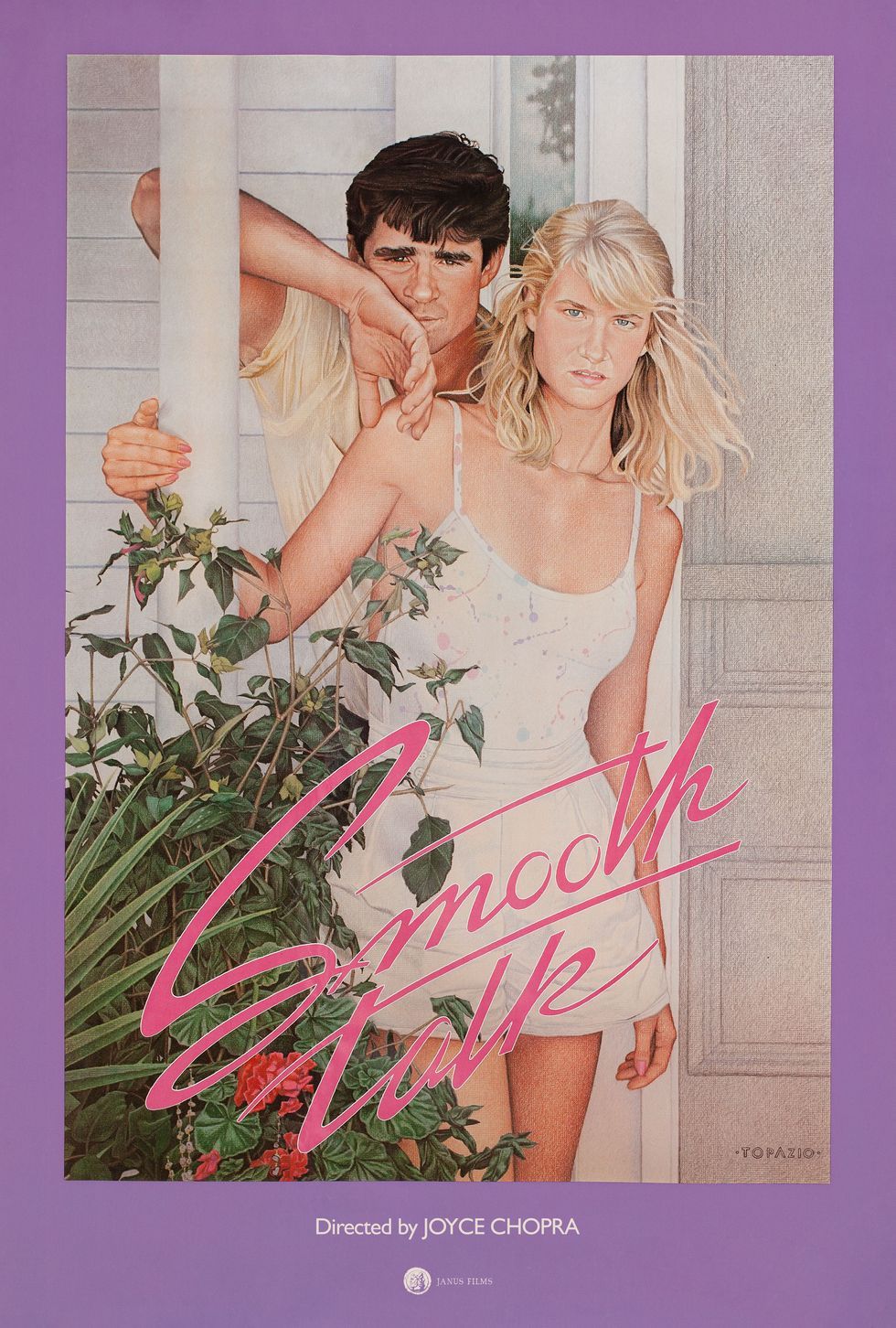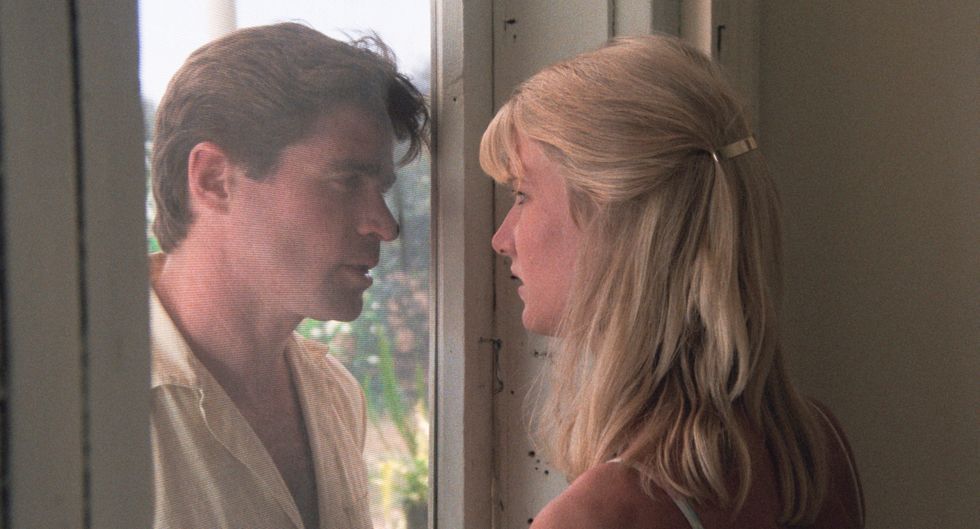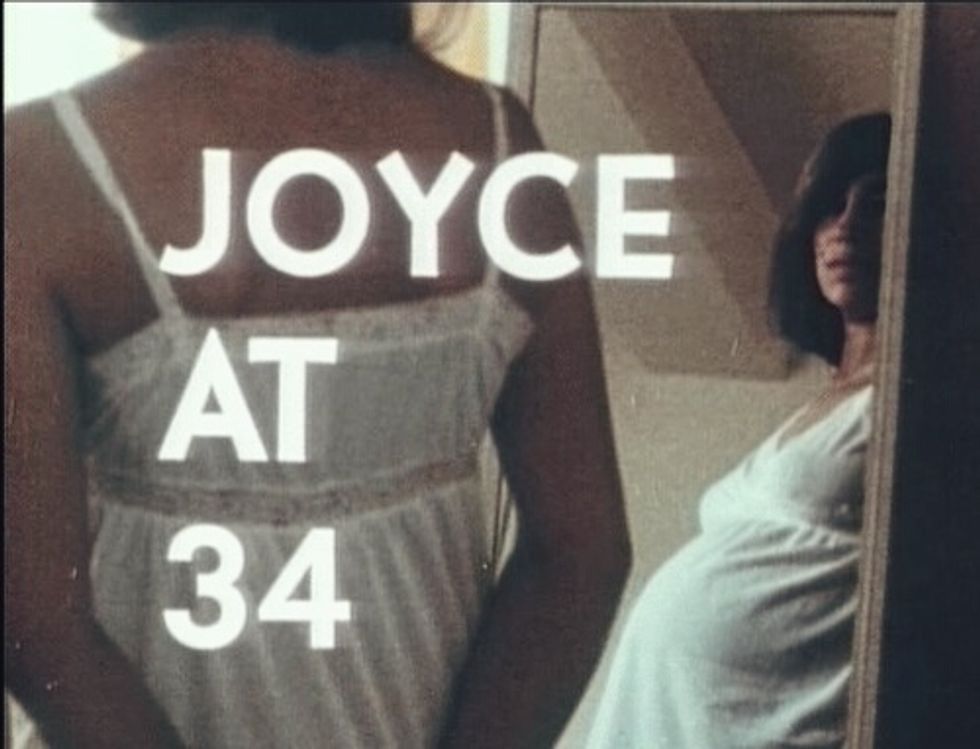
Photo courtesy of Janus Films

Blond tumbles across the screen, blond hair catching the lights of the mall, refracting in the glimmer of the sun, as gold as the gold-painted convertible jalopy that stalks her. This is Connie, she is 15, a little taller, a little more mature-looking, but still very much a child, trying on the identity of adult femininity like trying on a new lipstick at the retail counter. “Everything about her had two sides to it, one for home and one for anywhere that was not home: her walk, which could be childlike and bobbing, or languid enough to make anyone think she was hearing music in her head; her mouth, which was pale and smirking most of the time, but bright and pink on these evenings out,” wrote Joyce Carol Oates in her short story “Where Are You Going, Where Have You Been?” First published in Epoch Magazine in 1966, it's an eerie ode to the serial killers of the Sixties and the youth folk ballads of Bob Dylan. It’s that wild innocence that attracts Arnold Friend to Connie’s door one afternoon when she’s home alone; an older man who lures and threatens her with a ride in his car. In the 1985 film “Smooth Talk,” Joyce Chopra directed Treat Williams and Laura Dern as Connie, based on a script by Chopra’s husband, Tom Cole. Previously, Chopra had been a documentary filmmaker, whose work included a notable self-reflective video essay on new motherhood and career goals with a confessional but matter-of-fact sensibility called “Joyce at 34.” Later, she would adapt another of Oates’ works, “Blonde,” a fictional account of the life of Marilyn Monroe. Now a resident of Charlottesville, Va., Chopra previously lived in Kent and Roxbury, Conn. Her new book, “Lady Director” takes a look back at her multi-decade career — Joyce at 86.
Alexander Wilburn: Your film “Smooth Talk” was recently inducted into The Criterion Collection, how did they approach you?
Joyce Chopra: It was all through the producer of the film, and Criterion was very happy to have it, and they took other films of mine as well, all the others are documentaries. I’m so honored to be in The Criterion Collection, it’s wonderful.
It must feel like a real moment as a director. I would imagine there’s a thrill getting the Criterion copy.
Absolutely. Yes, you understand, I was thrilled.
I think it really means you’ve created lasting art, which doesn’t always end up being true for every director.
I have two films I feel that way about. I did a documentary called “Joyce at 34” which is in the permanent collection in the Museum of Modern Art, and when that happened — my god, I have a film in the Museum of Modern Art. Criterion was wonderful to deal with, they went through the negatives and color-corrected and cleaned them up, they did a great job.
You’re there with a fairly small number of female directors in Criterion, Claire Denis, Agnès Varda, Sofia Coppola… not a ton.
There can’t be, because there aren’t that many prominent women directors. I haven’t looked to see what the percentage is, but when you think of how few feature films were made by women it’s not surprising.
What was the landscape for you like when you were starting your career?
In 1958 I couldn’t think of any women directors, I thought I was crazy to even think of something like that. There weren’t any film schools and there weren’t any history books about women who made movies all through the 1920s and 30s. There were quite a few. Dorothy Arzner… that all disappeared in the 1940s. It was not easy to do something like that. But I did. I just kept trying to get a way in, some way or the other. It’s still not great for women as film directors, but it’s gotten a lot better for women as television directors.
It really does feel like our present television industry has opened a landscape for women that has been closed off in film.
I think it’s changed in the years, particularly after the MeToo movement. I did an episode of “Law & Order: SVU” in the early 2000s, they were going into their fourth season, and there are… I don’t know, 20 episodes a season? They had only hired two women in those four years. When they hired me, the producer who ran the show was constantly over my shoulder, found fault with everything I did, and made me so nervous. He was really horrid to deal with and I was never, quote end quote, “asked back.” It really was like that up until three or four years ago, and now about 40% of episodic television is being directed by women. Not features… but that’ll come, that’ll come.
How did you first encounter the Joyce Carol Oates story “Smooth Talk” is based on?
I found it in the O. Henry Prize short story collection. Joyce Carol Oates and my husband, Tom were both selected for prizes that year. I could never forget the story, it just terrified me.
It’s a very unnerving story about youth, even if the end is quite interpretative.
What do you mean by interpretive?
Open to interpretation I should have said. It’s not conclusive, you imagine with some horror what happens to Connie in the end once she gets in Arnold's car.
It’s allegorical. We changed the ending because we couldn’t possibly film that ending. My husband wrote the script and we couldn’t bear to kill our character. We wrote the ending while we were filming, we just learned so much through the filming process based on how Laura Dern was playing Connie.
Another big change from story to the screen was the time period.
We tried to be vague about it, but on the other hand, we made it in 1985, but there are no computers, no cell phones. So it’s hard to… when did you think the film was set?
I did feel like there was the shadow of Reagan over the film. But maybe that’s my interpretation of it, looking back at it as someone who wasn’t alive then.
Possibly. In the story there aren’t many details, there’s no father, there’s no town, and there’s a lot for the reader to fill in, so in a way, it was an easy story to adapt. Joyce Carol Oates suggests with a sentence here and there what would become whole scenes in the film. Most of the story is Connie’s confrontation with Arnold Friend, which we changed very little of, although Treat [Williams] changed some of it. He didn’t want to say what Arnold says in the story, “If you don’t come out I’ll burn your house down.” He changed it to “What if I burned your house down?” It fits in more with the way he was playing Arnold. Do you know how I found Treat Williams? He went to The Kent School. He was roommates with the man who became head of the school, Father [Richardson] Dick Schell. I was talking to Dick, we were rather friendly, and when he mentioned his former roommate Treat Williams I said, “Oh I’d love to cast him as this character.” So hurray for Litchfield County!
I read Laura Dern was discovered on the beach in California.
Yes, my producer was on the phone with a woman who lived on Malibu Colony Beach, complaining about how we hadn’t found anyone to play Connie. And this woman said, “I know her.” She was acting as if Connie the character was a real person. She said, “She’s walking by my window right now.” It was very odd. But the girl was Laura Dern. So I called Laura to set up an audition, and on her answering machine was playing the song that’s in the script, “Handy Man” by James Taylor. There’s another coincidence. James at that time was living in Kent. This was a Kent production. That’s why I’m happy to come back and talk there. James Taylor was a neighbor, he came by our house one night for dinner. He knew Tom and I were writing a script and were excited about it. He asked to read it and he came back the next night and said, “I want to be part of this, I want to write music for it.” I was very fortunate with all these connections, and then Laura was perfect.
She’s a great reactor on screen, you can read so much into her face during that very long scene she does with Treat Williams.
I have no idea how she does it, but she’s very in the moment. Treat was very active at that point, he was booking a lot of film jobs, so he could only give us one week of his time. We ran out of time and we still had to film the close-ups of Laura behind the screen door. Treat had left, so I read off-camera for Laura. She could have performed with a lamppost.
You would never know that watching.
You could never tell in a million years.
You had a screening of "Smooth Talk" recently and another coming up on Nov. 20 at Film Forum in New York.
There’s a film festival where I live in Charlottesville called The Virginia Film Festival and they showed it the other night. For me, it was a big night, and it was a big audience. I think the reaction was bigger than ever. People were, I can’t say awestruck, that’s so ridiculous, but I felt the audience was really knocked out about it.
There have been other adaptations of Joyce Carol Oates' work since "Smooth Talk," including some French films like "The Double Lover" by François Ozon, but you were one of the first.
And now there’s "Blonde" that’s just come out on Netflix.
I was going to ask you about that.
Have you seen it?
I have. You had your own adaptation of the book.
CBS did a miniseries of "Blonde" in 2001. I wasn’t involved with the script writing, but I directed and we did have a terrific cast. It’s strange now that the new “Blonde” has come out, and I’ve been doing interviews. People want to know what I thought of it, and I’m not very eager to say. I was told it would be really good publicity because Hollywood Reporter wanted to interview me, but I said I don’t want to say negative things about it and I didn't want to see it. [Andrew Dominik] has been trying to make “Blonde” for 10 years, and I sympathize with that. I finally… got talked into it. So I watched the new “Blonde” the night before the Hollywood Reporter interview, but I managed to avoid saying what I really thought. I don’t like saying negative things about another director. I wouldn’t want anyone to do it to me.
Dominik's film has been controversial with critics, some have written it feels exploitative of its female character When it came to your adaptations of Joyce Carol Oates' work, do you think there was something about having a female director adapt a female author’s fiction?
My husband Tom, who unfortunately died a while back — we shared in conceiving the scenes, but he did the actual dialogue writing. He would always surprise me, with things I never would have thought of. When Tom died The New York Times did an obit, and they called Laura to ask what it was like working with him. I’ll misquote her, but she said something like, “Here was this 50-year-old male MIT professor telling me what it was like to be a teenage girl... And he was so wonderful and so able to help me with this role.” That was the biggest compliment Tom could have gotten. I don’t feel my being a woman had to do with anything, it was working with Tom, that was the world we wanted to create.
Joyce Chopra will discuss her book “Lady Director: Adventures in Hollywood, Television and Beyond” on Nov. 18 at House of Books in Kent, Conn.

Photo courtesy of Janus Films

Photo courtesy of Janus Films

Photo courtesy of Janus Films
NORFOLK — Robert J. Pallone, 69, of Perkins Street passed away April 12, 2024, at St. Vincent Medical Center. He was a loving, eccentric CPA. He was kind and compassionate. If you ever needed anything, Bob would be right there. He touched many lives and even saved one.
Bob was born Feb. 5, 1955, in Torrington, the son of the late Joseph and Elizabeth Pallone.
Bob graduated from Babson College, one of the most prestigious accounting schools out there.
He built his own CPA practice in 1987. He was an accurate and accountable accountant. He would always say during tax season that taxes are an art not a science. He took time to teach his employees his art of taxes.
Bob was also a landlord and owner of the Royal Arcanum, where he met his long-time friend of over 20 years, Michael Dinsmore. The two of them together experienced many great times. They would always be laughing and singing some of their favorite songs. Bob would always say that the Royal Arcanum was his baby. He loved that building and took great care of it. During his time at the Royal Arcanum and owning his business, he met a lucky lady, Melissa Baresi. Little did they both know that Robert and Melissa would become the best of friends and even turn into family. Melissa is considered to be Bob’s Girl. Bob is the reason Melissa has such a great life today.
After retirement, another one of Bob’s lifelong friends, Dana Devereux, was there to help Bob get accustomed to retirement. Retirement can be scary especially to a person who worked all his life. It was during this time that Bob was diagnosed with cancer again. Dana was there to lend a helping hand while Bob had to go through chemo.
Bob was truly a remarkable man and was blessed to have such great friends like Michael, Melissa and Dana. He would always say if you can count the number of friends you have on one hand then you truly made it. Made it, Bob did.
A graveside service will be held on Wednesday April 17, 2024, at 2:00 p.m. at the Pond Town Cemetery in Norfolk, CT.
He will be buried next to his mom and dad where he always wanted to be.
Any memorial donations may be made to the ASPCA. Bob was an animal lover and had many cats throughout his life.
The Kenny Funeral Home has care of arrangements.
"Flowers" by the late artist and writer Joelle Sander.
The Cornwall Library unveiled its latest art exhibition, “Live It Up!,” showcasing the work of the late West Cornwall resident Joelle Sander on Saturday, April 13. The twenty works on canvas on display were curated in partnership with the library with the help of her son, Jason Sander, from the collection of paintings she left behind to him. Clearly enamored with nature in all its seasons, Sander, who split time between her home in New York City and her country house in Litchfield County, took inspiration from the distinctive white bark trunks of the area’s many birch trees, the swirling snow of Connecticut’s wintery woods, and even the scenic view of the Audubon in Sharon. The sole painting to depict fauna is a melancholy near-abstract outline of a cow, rootless in a miasma haze of plum and Persian blue paint. Her most prominently displayed painting, “Flowers,” effectively builds up layers of paint so that her flurry of petals takes on a three-dimensional texture in their rough application, reminiscent of another Cornwall artist, Don Bracken.
Sander’s first book, “The Family: The Evolution of Our Oldest Human Institution,” was published in 1978 while she worked as an instructor with the Institute of Children’s Literature. She described the history book, which took young readers on a journey of the evolving family unit from the Ice Age to the 1970s, as a kind of anthropological tour. “Kids are exposed to so many families in this culture,” she told The Lakeville Journal at the time. “I felt the book would give them a perspective on families in other cultures, both historical and contemporary. In 1992, The Lakeville Journal reviewed another of her published works, “Before Their Time: Four Generations of Teenage Mothers,” which Sander wrote as a faculty member at Sarah Lawrence in Westchester County, N.Y., where she served as the associate director of The Center for Continuing Education and taught modern American poetry. She was also a volunteer at a New York YMCA. At this YMCA, she met a young single mother named Leticia, whose trauma, struggles and hopes for the future inspired Sander to share Leticia’s story as told through the personal histories of the women who had come before her. Lakeville Journal writer Richard O’Connor called the book’s psychological exploration of cyclical poverty both “wonderful and disturbing.”
Her first slim volume of poetry, “Margins of Light” was available for attendees of the show to read while they examined Sanders’ paintings, a dual experience to take in the twin passions of her lengthy artistic career.
“Live It Up!” will be on view at The Cornwall Library through Saturday, May 18.

Rabbi Zach Fredman
On April 23, Race Brook Lodge in Sheffield will host “Feast of Mystics,” a Passover Seder that promises to provide ecstasy for the senses.
“’The Feast of Mystics’ was a title we used for events back when I was running The New Shul,” said Rabbi Zach Fredman of his time at the independent creative community in the West Village in New York City.
He has since relocated with his family to Germantown and founded Temenos, “a home for ritual and creativity that honors the wild humanity of all people,” as the website explains (temenosnyc.com). At these feasts, Fredman and his brother, a chef, would create a menu to highlight the symbolism and mythology of certain Jewish holidays.
“People loved it,” explained Fredman. “It’s kind of a two-pronged approach, a way to engage and digest symbolism through the belly.” The Seder (which means “order” in Hebrew) at Race Brook will be such an immersive experience: a four-course meal conducted in four parts, echoing the four cups of wine consumed during the ceremony.
Alex Harvey, arts programmer at Race Brook, and his wife, Sophia Akilova, have known Rabbi Fredman through various communities and music circles for many years. After moving to the Hudson Valley from Brooklyn, Akilova was “looking everywhere for some kind of Jewish community that was dynamic. There’s plenty of progressive Jewish communities,” Harvey continued, “but she was looking for something way more particular, a community that is rediscovering active prayer, actually somatic spirituality.”
Fredman spoke of Passover as an opportunity to reconnect with tradition while investigating present day reality through the core liberatory framework of the holiday. He said, “One of the major successes in Judaism is that the tradition was conceived as living. There’s the written material that’s passed on, that’s unchanging, but it’s always accompanied by oral teachings, teacher to student, teacher to student. And so there is a sense that tradition is alive and dependent on people making it fresh, making it new.”
The tradition will be made new once again with the addition of music at Race Brook by the powerful and virtuosic Duo Andalus with vocalist Lala Tamar. Tamar and Fredman, who is an incredibly accomplished musician as well, have been collaborating through Fredman’s group Epichorus for many years. Fredman will join Duo Andalus throughout the evening and the following evening (April 24), Epichorus featuring Tamar and Yacouba Sissoko, who plays the African Kora, will perform.

There are four questions that are asked during a Passover Seder, traditionally by the youngest person at the table. One of those questions is: “Why is this night different from all other nights?” Much of the rest of the Seder is in response to this question. When asked this particular question, Rabbi Fredman offered, “It’s been so overwhelming to watch the news cycle. It’s been a year where Judaism, Jewish identity, Jewish ethics, all of these things are completely different from what we thought they were even a year ago.” Fredman went on to speak about the fracturing that is occurring within the Jewish community and offered, “One of the functions of ritual, especially a ritual like this one, is to create space for people to have the conversations that we need to have.”
Creating a safe container for difference and for questioning is a tall order and one that Fredman meets with humility and curiosity. Of the Passover Seder he shared, “I’m hoping that in addition to the elements of food, and music, and teachings that there’s also space for people to be vulnerable and sift through some other profound experiences, painful experiences of the last six months and then, you know, investigate, turn things over and find something about themselves that helps us make sense of a disorienting moment.”
Reservations for Feast of Mystics, and The Epichorus featuring Yacouba Sissoko and Lala Tamar can be made at rblodge.com.
Warren Prindle
Legendary American artist Jasper Johns, perhaps best known for his encaustic depictions of the U.S. flag, formed the Foundation for Contemporary Arts in 1963, operating the volunteer-run foundation in his New York City artist studio with the help of his co-founder, the late American composer and music theorist John Cage. Although Johns stepped down from his chair position in 2015, today the Foundation for Community Arts continues its pledge to sponsor emerging artists, with one of its exemplary honors being an $80 thousand dollar scholarship given to a graduating senior from Housatonic Valley Regional High School who is continuing his or her visual arts education on a college level. The award, first established in 2004, is distributed in annual amounts of $20,000 for four years of university education.
In 2024, the Contemporary Visual Arts Scholarship was renamed the Warren Prindle Arts Scholarship. A longtime art educator and mentor to young artists at HVRHS, Prindle announced that he will be retiring from teaching at the end of the 2023-24 school year. Recently in 2022, Prindle helped establish the school’s new Kearcher-Monsell Gallery in the library and recruited a team of student interns to help curate and exhibit shows of both student and community-based professional artists. One of Kearcher-Monsell’s early exhibitions featured the work of Theda Galvin, who was later announced as the 2023 winner of the foundation’s $80,000 scholarship. Prindle has also championed the continuation of the annual Blue and Gold juried student art show, which invites the public to both view and purchase student work in multiple mediums, including painting, photography, and sculpture.
HVRHS students who have received the scholarship from the Foundation for Community Arts have continued their education at notable institutions like Pratt Institute, the School of the Museum of Fine Arts Boston, Parsons School of Design at The New School, Florence Academy of Art in Rome, The Fashion Institute of Technology, San Francisco Art Institute, Tisch School of the Arts at New York University, The Rhode Island School of Design, and The Savannah College of Art and Design.
HVRHS students can receive application forms for the scholarship from their teachers or councilors and the winner will be announced shortly before the end of the school year. The deadline for the scholarship application process has been extended to April 24.